#societal reflection in art
Text
"Riding the Waves of Fury: Finding Peace Amidst the Canvas of Conflict"
Yo, Wynter Blog fam, we’re diving deep into the ocean of emotions with a canvas that’s a straight-up visual explosion titled “Anger & War.” This isn’t your chill wave to ride; it’s a stormy sea of reds and blues clashing like rival gangs under a sunset sky. The painting throws punches with its vibrant hues, splatters, and strokes that scream louder than a back-alley showdown.
Imagine rolling…

View On WordPress
#abstract art#abstract expressionism#anger in art#art and society#art for peace#contemporary painting#emotional canvas#healing through art#love over war#peace through creativity#resolution through art#societal reflection in art#transformative art#war impact on society
0 notes
Text
One of the many, many reasons I love Blade Runner is that it doesn't have this Big Epic Final Fight you've come to expect from literally any action film ever.
There's just Deckart and Roy - all others are dead, or not here - and it's just them and one was supposed to kill the other and has become the hunted.
Our main hero protagonist is at the end, he's beaten down, he's at the brink of death, he can barely still walk and is just fleeing as far as he can, as long as he can, and he won't be able to go on much longer and there's really only so far he can run before he's inevitably caught. There's no last minute saviour, no sudden burst of strength, no last attempt to fight. He's terrified. He's running, limping, for just a few seconds more.
And the antagonist - the one who was supposed to be killed, the one who was supposed to be sub-human and is living his life as a slave, in fear - he's going mad. He barely ever had anything, and he lost the few others he had - the only ones who understood when the world was against them. He has only minutes to live, minutes that not even his creator - his god, almost - could drag out, a human god who died by his bare hands. There's nothing left to lose and nothing left to do, but there's the person who hunted him down like a machine or an animal that's one rogue, the one supposed to kill him, entirely at his mercy.
And then they're on that roof, and I don't know what Roy might think, but I know Deckart was done with his life. I know he was convinced he'd die right here - that both of them would die on this roof in the rain.
And when Roy pulls him up? There has to be an explanation. Surely he'll kill him now. What else could he possibly want?
But Roy isn't out for revenge anymore. For as little as he's lived, he's seen so incredibly much. And he knows there isn't anything to be done. He'll die, he'll be forgotten, just another rogue replicant - like moments in time, like tears in rain.
"Time to die." No sadness, no anger, nothing. There's nothing more to it, not anymore. It's a fact.
It's when he's free for the first time.
He's no longer living in fear. He died on his own terms. He's as free as he could ever be, in the only way that was ever even a possibility. And as he dies, as he no longer lives as a slave, that white dove flies away through the rain - a symbol of freedom, finally let go.
And Deckart is left alone on that roof, bleeding, his hand broken, exhausted, still not quite away from the brink of death he's been limping along for the last, what, minutes? (How long was it? Can't have been long. But it sure felt endless.)
There's no winner. No one has been defeated, either. There's just one who died, as he was always meant to, and one who lived, but his world might be in shambles.
What is life worth when you're just waiting for death? Is it freedom when you can never settle down? Could there ever be a different ending?
Also I'm going absolutely insane over the white dove which is a symbol for freedom btw like DAMN!!!!!!! IMPLICATIONS!!! AHHHHHHHHHHH!!!!!
#i mean im basically going insane over the entire film#but especially that climax??? HOOOOOLY---#a biscuit's rambles#blade runner#blade runner 1982#there is just SO MUCH in this film#and im only super obsessed with the last part at this point bc it stuck with me and otherwise i was following the plot along#just wait until i rewatch the film and start analyzing EVERY SINGLE THING IN THERE#this has REALLY made me realize how much i love film analysis actually#like yesssssss make me think about messages and symbols and metaphors and the creators' intentions#also the time at which it was made like i once read an article about how horror reflects societal fears#and now im applying that to all films that leave an impact on me#like what does it say about the era in which both blade runner and truman show were made? (human goes against god who is actually also huma#but also very much god)#LIKE!!! i mean it was a time of loooots of changes! really big changes! the world was going fucking nuts!#WHAT DOES ART SAY ABOUT THE PSYCHOLOGY OF THE PEOPLE WHO MADE IT WHAT DO FILMS TELL US HOW IS SYMBOLISM USED#I AM GOING INSANE OVER THIS OK#I AM NOT FINE#I NEED TO REMEMBER HOW TO PUT THE FUCKIGN CHAIRS FOR A CONCERT NOT THIS NOT NOW AHHHHH#okay im normal again#(<- lie fy is still thinking about this and frothing at the mouth)
36 notes
·
View notes
Text
heaven as a foucaultian heterotopia :[
#a place removed from its surroundings in which societal roles and hierarchies are reflected and refracted#a great big bed. a room in an art gallery. a castle on a hill with towering walls.
2 notes
·
View notes
Text
Thinking abt things...
Say you have characters from a mythological or ancient source. like Grendel and his mother. ...specifically, Grendel and his mother. These are figures that are monstrous, eat human flesh etc etc. Across recent-ish history (1400s-present), they've been racialized by white authors along various lines, usually being heavily black-coded and fitting very well into that DEEPLY RACIST narrative. They also exist in a field (anglo-saxon studies) that is VERY White Supremacist, even/especially in academia.
now here's me. a white author. I've been writing these characters (in terms of analyses, original stories, putting them in fanfics/fanwork, etc) for a few years. I'd originally made the conscious choice to have them both be white, primarily as a conscious denial of the existing (negative)racialization of these characters, but also because I do not feel that I, as a white author, could or should attempt to portray characters like this through a racialized lens. I've seen other white authors that I otherwise respect try to do Grendel & his mother this way- and hooooo boy did it make me uncomfortable. great critical acclaim from the community but i felt like i wanted to squirm out of my skin. y i p e s. good message, pLEASE DONT WRITE THAT YOU'RE A WHITE WOMAN WHO HAS NEVER EXPERIENCED ANY OF THIS
however... the more I look at these characters and this field as a whole, the less comfortable I am discounting/ignoring the presence of race here. like its ridiculous, and harmful, and racist not to. there's plenty of writing abt it.
however, I also worry about the implications of me, a white creator, making the decision (even just re: my own work) that these characters/narratives "aren't meant for white people anymore". far from being reparative/restorative justice, I feel like I'm veering very far into assigning these monstrous figures to black/BIPOC authors "because they have more of a right to use/understand that narrative than we (white ppl) do"... and that's. also probably very racist. I think.
the closest thing I've gotten to a conclusion here is that racialized AND nonracialized/non-BIPOC-centric depictions of Grendel and His Mother are both okay, good and maybe even (assuming the non-racialized ones still have SOME kind of message or story to tell) necessary. It's harmful to deny race around these characters or try to write them "color-blindly". It's also (though this I'm less sure about) harmful as a white author to "give up" these characters due to some percieved (read: stereotyped) idea that they're more "needed" in nonwhite communities.
...however.... where does that balance leave me, a white author who wants to write about, cosplay, make fic about, and generally love these characters?
I'm not sure I can like them anymore-
but again that feels like overthinking in the most problematic way possible.
I would genuinely love feedback/critique here bc I'm just going around in circles on this....
#Grendel#folklore studies#narrative analysis#critical race theory#academia#yeah kinda shading Maria Dahvana Headley for this#certain parts of The Mere Wife just make me....ewwwww#tw racism#white guilt#if we're being honest#critique#self critique#self reflection#trying to b conscious of my art's implicit biases and motives#probably overthinking it to the point that its now Worse#ive done that kind of over-course-correcting-til-it-loops-back-to-being-racist before#so ik i have to watch out for that trend in my worldview#navel-gazing artist crap#not even getting INTO my constantly projecting these characters onto the main cast of Notably Pretty Fucking Racist Show SUPERNATURAL#figure out the Actual Broad Societal Context before even starting to poke at that
2 notes
·
View notes
Text
The thing about media analysis is that yes, things really can be that deep even if the artist didn't put the thought into it intentionally.
Little cultural references, personal artist quirks, broad societal influences, unacknowledged biases...there are countless things in a piece of media that can betray subconscious beliefs and values held by the artist, even if the artist wasn't doing it on purpose. Even bad art can be picked apart for its themes, even shallow art can reflect something about the world and the person viewing it.
Any given piece of art has the potential to be however deep you're willing to dig for it, even if the artist didn't dig that deep on their own.
11K notes
·
View notes
Text
Was going back through the Crazy Ex-Girlfriend music videos to revisit Rebecca’s songs, and it genuinely blows me away how much they just...let her look like a regular person.
#obviously rachel bloom is an attractive woman and she didn't look BAD but she just. was a person living her life. she looked nice and a bit#more made-up in the songs where she was specifically meant to be more Formal or Sophisticated but she was still like. realistically pretty?#like she looked like a person who looked particularly nice for a specific occasion#and when that WASN'T the case she just...looked like a person. she existed as herself with clothes that reflected her style and she wasn't#airbrushed or perfectly put-together or made over into this unachievable standard of prettiness literally she just existed#my god. I don't actually think I'd ever seen that before and now I want to cry about this show and about Rebecca all over again#(and yes the reason for this is likely because rachel bloom had a lot of say over her own show but my god do I appreciate her doing that)#NO ART IS /NOT/ SYNONYMOUS WITH BEAUTY I DO /NOT/ HAVE TO PERFORM CERTAIN STANDARDS OF ATTRACTIVENESS TO BE WORTH CARING ABOUT#NO WOMEN /AREN'T/ ONLY MEANINGFUL IF THEY LOOK THEIR PHYSICAL BEST ACCORDING TO SOCIETAL BEAUTY CONFORMITY STRICTURES AT ALL TIMES#NO IT /DOESN'T/ DETRACT FROM THE EXPERIENCE OF WATCHING SOMETHING IF THE PEOPLE DON'T LOOK OVERLY **SEXY** AT ALL TIMES#APPEARANCES /DON'T/ MATTER ACTUALLY!!!!!!#THIS IS THE ONLY SHOW EVER THE ONLY ONE#mc13's routine cxgf media breakdown
2 notes
·
View notes
Note
What are essay videos of horror movie you watch
oh my god yes, i have like an entire collection of them on youtube
how media scares us: the work of junji ito
what are we afraid of? societal fears reflected in film
the art of texas chainsaw massacre: making daylight scary
the importance of horror (why horror movies don't suck)
the grunge & ringu: what makes japanese horror creepy?
the vvitch - art of terror
how horror movies for kids dominated in the 90s
the shining analysis - tension, atompshere & mystery
creating suspence in a horror films
the art of scream: horror logic done right
wolf creek: australia's most infamous horror movie
why cosmic horror is hard to make
color theory in horror movies
society and queer horror
horror theory: the uncanny valley
the childhood horror of coraline
control, anatomy, and the legacy of the haunted house
elements of horror - don't look
the girlboss-ification of the horror genre
elements of horror - how eyes are used in horror movies
thai horror is so underrated
the history of insane asylums and horror movies
slender man (2018): misunderstanding ten years of the internet
the true history that inspired folk horror (part 1)
the true history that inspired folk horror (part 2)
the true history that inspired folk horror (part 3)
the history and evolution of jump scares
the complete history of horror movies
6K notes
·
View notes
Text
Pluto generations
Aries (1823 - 1851)
The presence of Pluto in Aries defines a generation marked by a pioneering and assertive spirit, reflecting a profound longing for independence. Those influenced by this placement often take on key roles in instigating social change and revolutionizing established systems. Historical events from 1823 to 1852, such as the Wars for Latin American Independence, the First Opium War, and the Women's Rights Convention, exemplify the transformative impact of this astrological configuration.
Taurus (1852 - 1881)
Pluto's position in Taurus defines a generation characterized by unwavering perseverance, determination, and a profound connection to the material realm. These individuals prioritize stability, security, and the sustainable use of resources, leaving a lasting imprint on economic systems and environmental consciousness. Notably, during Pluto's transit in Taurus, the Industrial Revolution surged forward, marked by the rise of corporate structures in industries like railroads and steam engines.
Gemini (1882 – 1913)
The generation under the influence of Pluto in Gemini witnessed the dawn of the Second Industrial Revolution, aptly named the Technological Revolution. These individuals, marked by intellectual curiosity and adaptability, excelled in communication and media, significantly shaping cultural and technological progress. The era marked the birth of influential figures like John Maynard Keynes and Benito Mussolini, along with German scientist Robert Koch's identification of the tuberculosis bacterium. Notably, the First World War occurred during this period, bringing significant changes in all areas of life.
Cancer (1914 -1938)
Pluto in Cancer signifies a generation characterized by deep emotional sensitivity, nurturing instincts, and strong family values. Living through World War I, the Spanish flu pandemic, and the Great Depression, they grew up in a challenging era that shaped their conservative outlook. This generation, often referred to as the "Greatest Generation," prioritized family, spirituality, and adherence to societal norms. While their emphasis on politeness and chivalry had positive aspects, it also gave rise to dark elements such as sexist gender roles, racial segregation, and cultural supremacy.
Leo (1939 – 1958)
Pluto in Leo defines a generation marked by a quest for self-expression, creativity, and a hunger for recognition. Born during historical events like the Nazi invasion of Poland and the Battle of Stalingrad, these individuals challenged authority, imprinting their influence on art, entertainment, and leadership styles. Ruled by the Sun, Pluto in Leo symbolizes a fresh start after periods of war and chaos, fostering a sense of self-value and confidence. This prideful, generous, and naturally leadership-oriented generation, however, tends to resist change and stands firm in their philosophies as a fixed sign.
Virgo (1957 – 1971)
Pluto in Virgo defines a generation marked by a robust work ethic, practicality, and an innate drive for perfection. Born during pivotal events such as the first documented AIDS cases and Martin Luther King Jr.'s iconic "I Have a Dream" speech, these individuals contribute to societal shifts in health, wellness, and environmental consciousness. Ruled by Mercury, Pluto in Virgo emphasizes efficiency and hard work, fostering reliability, trustworthiness, and empathy. This generation focuses on rebuilding and technology, epitomizing an era of research and preparation, notably during the Cold War.
Libra (1972 – 1983)
Pluto in Libra defines a generation marked by a profound yearning for harmony, justice, and equality. With Venusian qualities, these individuals are inherently social, compassionate, and value connections with others. The events during their time, such as the end of the Vietnam War, the introduction of VHS, and the rise of personal computers, align with their commitment to justice and duty for the collective. This generation, while not necessarily seeking radical societal reshaping, is more focused on preserving law and order, offering assistance to those in need, and rectifying wrongs through the pursuit of justice.
Scorpio (1984 – 1995)
Pluto in Scorpio defines a generation marked by intensity, depth, and profound transformation, playing a pivotal role in societal shifts related to power dynamics, sexuality, and psychological exploration. While the preceding Pluto in Libra generation advocated for balance, Pluto in Scorpio pushed the limits, ushering in events like the Gulf War, the end of the Cold War, and the advent of the World Wide Web. Resilient and empowered, they navigated constant transformations, developing a keen ability to adapt and thrive through each metamorphosis. This generation also contributed to a shifting cultural perspective on sexuality.
Sagittarius (1996 – 2008)
Pluto in Sagittarius shapes a generation marked by a thirst for knowledge, cultural exchange, and a global perspective, contributing significantly to societal shifts in education, philosophy, and belief systems. This generation, embodies the archer's bravery and fearlessness, fostering a spirit of rebellion and outspokenness. Sagittarius' affinity for networking and socializing with individuals from various nations aligns with the rise of the internet, a tool that facilitates global connectivity. Key events during this period include the successful cloning of Dolly the sheep, the introduction of the Euro to financial markets, and the groundbreaking launch of the iPhone in 2007.
Capricorn (2008 – 2023)
Pluto in Capricorn defines a generation marked by ambition, pragmatism, and a distinct focus on challenging traditional structures, leading to transformative changes in politics, business, and governance. Ruled by Saturn, this era, encompassing events such as the launch of Bitcoin, the Syrian civil war, Edward Snowden's revelations on mass surveillance, and the COVID-19 pandemic, unfolded amidst the Great Recession and the rise of social media. The influence of Saturn instils a commitment to rules, regulations, and social changes that align with a desire for structure and order.
Aquarius (2024 – 2044)
Pluto in Aquarius heralds a generation marked by innovation, individuality, and an impassioned pursuit of freedom and social progress. The current era unfolds amid a new global order, carrying both anticipation and uncertainty. Emerging from the constraining Capricorn era, Aquarius brings a promise of hope, healing, and a future-focused mindset.
Pisces (2044 – 2067)
Pluto in Pisces gives rise to a generation marked by empathy, spirituality, and a deepening of the collective consciousness, contributing to societal shifts in compassion, art, and transcendence. As one era concludes and another begins, this period signals the resurgence of spirituality, with people connecting profoundly to the universe through meditation and prayer. Anticipated as a peaceful time with minimal conflict, technological progress may temporarily slow after the Aquarius era's boom. This wise generation is poised to challenge traditional norms, potentially leading to the disappearance of gender roles, marking a significant chapter in human evolution.
#astro observations#astro community#astro placements#all signs#astrology#astro notes#astrologer#for you#zodiac placements#pluto#planets#predictive astrology#astrology notes
704 notes
·
View notes
Text
one thing that continues to plague my thoughts about AI “art” is how quickly non-artists accept it as some form of expression. It’s a reflection of the societal norm that art is wholly unnecessary unless created for maximum profit gain, yet techbros FLOCK to the idea of a computer generating an entirely “new” image, a Frankenstein mimicry pulled from pre-existing works uploaded to the internet by actual people, based off of a few key words they feed into the program. They call it revolutionary. They call it accessible. They call it groundbreaking.
Art has always been accessible. Everyone has had the proper tools to become an artist since birth, no matter what background one might have come from. Non-artists crave a sense of accomplishment, of creating something big, of being the cause of something downright spectacular. But art is hard. No one has the time to pour into an activity and build upon a skillset that takes years to even get a handle on.
Art takes a certain amount of discipline, and people don’t like that. The fruits of their creative labor cannot be seen as quickly as they want, and in an industry that pushes the pursuit of greater profit with the least amount of time and effort put in, art just cant catch up.
AI “art” will not satisfy you. It will not make you look smart. It is not groundbreaking.
That hole in your chest that craves that creative outlet, that needs that gratification--it will never be filled with AI. Those images your machine is vomiting will never amount to anything and you will never be an artist. Because being an artist requires discipline, passion, and most of all: emotional connection.
Being an artist requires you putting a part of yourself into your craft, and doing it for the purpose of passion and not monetary gain. Being an artist requires work, and loving that work.
AI cannot, and will never produce art
860 notes
·
View notes
Note
Hi Tracy, i wanted to ask a somewhat personal question. How do you deal with losing beloved pet? I recently lost my 9-year-old tortie a month ago to kidney failure and GDV and even though i still got three other babies to dote for (and they're all lovely), it's really hard to feel as much love as i did with my tortie. She was my first cat and was incredibly loving and patient with, helped me immensely while grieving for my father's passing a few years ago.
With her gone, it really does feel like a lot of me also went with her. It makes living very hard. I made tiny sculpture and wood soldering in her memory but i don't really know how to deal with the actual emptiness inside me. Sorry for the word vomit but i figured since you also lost a precious cat before, you might have insight for this situation
I'm so sorry for the loss of your beloved tortie.
I don't have any special skills for dealing with death, really, but I suppose I can speak a bit about personal experience.
I think it's natural to feel a yawning emptiness when something so intimately intertwined in your life - a constant companion, a source of joy, something around which your daily schedule is structured - is suddenly gone. It can be a very lonely sort of grief too, as the loss of a pet doesn't generally come with the same community and ritual that human death does. To others, your dear companion was perhaps just an animal. Not to equate it with human death in the broader scheme, exactly, but it can mean personal devastation, compounded by being alone in coping with it. Societally, we probably do ourselves some significant harm believing we must rapidly "get over" losses like this.
There's no getting-over-it that I know of, anyway, but there is the knowledge that the nature of grief changes over time (it sounds like you're no stranger to that). The stormy waves that knock you about with the immensity of the loss gradually give way to more placid waters. The sadness remains, but grows gentler and maybe sweeter even, because it creates a quiet space to reflect on the pet that enriched and graced a chapter of your life with their presence.
In the meantime, while awaiting some peace, I personally find there's an analgesic effect to making the feelings of grief actionable. The meditative nature of art and the act of memorializing a companion animal won't fill in that void, but it can help you start to process and accept it, to find a way to transmogrify it into a repository for your feelings and memories of love. I'd say keep making sculptures, make a scrapbook, draw a picture of her - anything, if it puts you in a different state of mind as you're doing it.
Looking after animals that are in need of care and attention in the moment, even if you feel emotionally distant, might help you regain some footing too. Setting up shelters for feral cats and fostering rescues are some things I like to do. There's a sort of grounding, self-rescue interwoven in focusing some energy on the living.
Most of all, grant yourself time. Do yourself the kindness of not feeling bad about feeling bad. Mourn without believing you must rush to find a cure for the sadness.
If, however, you are suffering or finding it impossible to function day to day, please do reach out to seek qualified counseling.
359 notes
·
View notes
Text
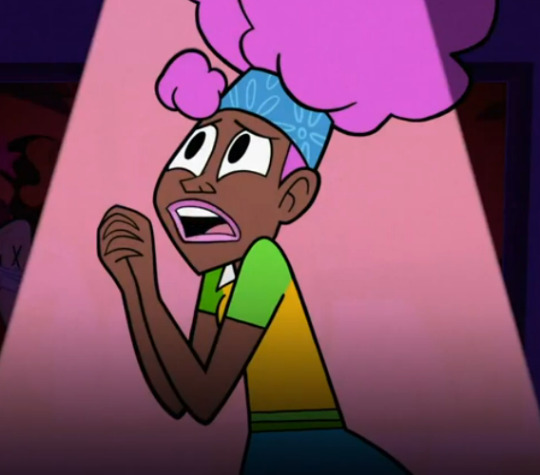
So Harriet has shown on screen that she is terrified of living a mediocre life on the shadow of her clone mother and that speaks so well to people of color’s pressure into fitting into white definition of success and societal approval and so many things about Harriet’s plot lines reflect that

Harriet is constantly trying to appease Joan and try to sound as friendly and passive as possible.
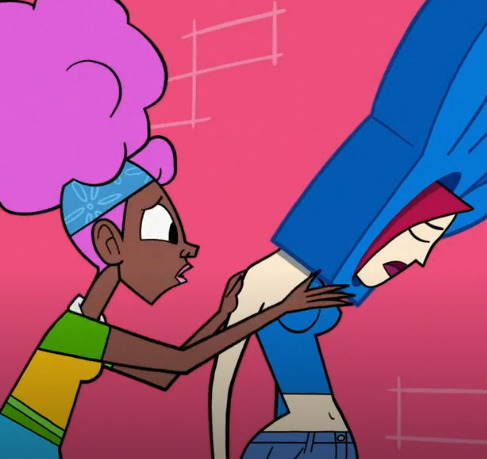
And then when Harriet makes the slight criticism toward Joan, Joan throws a pity party and Harriet needs to back away for JOAN’s feelings, it feels really implicit how Harriet is trying to live up to white approval, by making a show that would get hollywood’s attention, casting the hot white couple of the school, by TWISTING herself backwards just to please a white woman’s sensibilities.

And as a result Joan just completely disregards Harriet’s art and makes it her own, and makes it way more whitewashed, and set on medieval times for some reason? (You could argue it’s bc Joan of Arc’s real life) but also! The fact that so many art that’s met with prestige is white and old and European, Joan understands these things are “meaningful and deep” but that is only meaningful to a specific set of ppl, as opposed to Harriet’s wide-appeal show. Joan is convinced she’s on a moral high ground but the way she communicates is mainly through a white person’s biases when creating art.
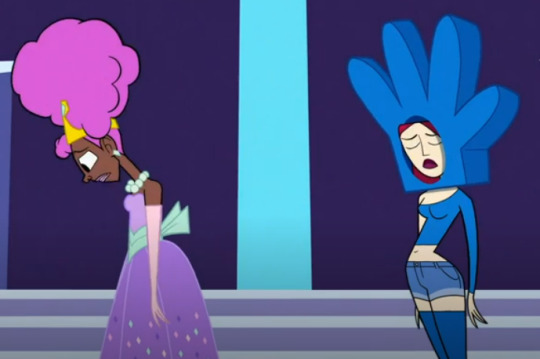
“I know I’m the clone of Harriet Tubman, but that doesn’t mean I can’t have fun silly stories too!”
Harriet genuinely likes the story she made and how silly and fun she is, but she lives in the shadow of an important social figure and is terrified of failing that image.
Many poc and specially black and brown ppl feel pressured into making their experiences and prejudice they face part of their art, that every black character on something set on the past is either a slave or non-existant, that art of color has to be about pain and tragedy that can spell out our suffering to a white audience, Harriet here wants to escape from the pressures from being a clone but also from being a black artist in 2023 in general.
The conflict between Harriet and Joan’s white womanhood is great bc it shows how Joan lets her feelings and desire to make a “meaningful” musical that is just a bunch of edgy stuff and white people is so well written, specially because it brings to question why do we make art at all? And how does one decide what kinda art they wanna make? Does making something black and white and dreary make it automatically more meaningful and therefore superior to a musical about twister? The answer to the last one is no, and I love how this episode showed these cool discussions.
And I haven’t even touched on the song about white guy confidence, because I think that was a plot b where that theme was the most apparent, and I wanted to show how the same theme of white privilege shows up in the plot a, Cleo, Carver, Sacagawea and Confucius also aim to get a white audience’s approval, that is what these characters all struggle with and it is an ungoing war called living through high school as a person of color
436 notes
·
View notes
Text
How to write an elderly main character?
I'm back! Because school is quite busy and I'm about to take exams, I don't have time to post new articles. I wonder if anyone remembers me. (probably not, lol)
There are many novels that feature elderly as main characters, for example, "The Hundred-Year-Old Man Who Climbed Out the Window and Disappeared" by Jonas Jonasson or "Our Souls at Night" by Kent Haruf. Today, I'll show you a few tips for writing this type of character.
When writing an elderly main character, it's important to approach the portrayal with sensitivity, authenticity, and a nuanced understanding of the aging process. Here are some tips to consider when developing an elderly main character:
Characterization: Create a well-rounded character with depth and complexity. Consider their personality traits, background, life experiences, and values. Remember that elderly individuals, like people of any age, can have diverse personalities and interests. Give your character hobbies, interests, and passions that reflect their individuality and bring richness to their life. Older adults can have a wide range of hobbies, such as gardening, art, music, or storytelling, which can add depth to their character.
Realism: Research and understand the aging process. Gain insights into the physical, cognitive, and emotional changes that commonly occur in older adults. This will help you create a realistic portrayal of your elderly character and avoid stereotypes or misconceptions.
Language and Dialogue: Reflect the character's age and life experience in their language and dialogue. Consider the vocabulary, speech patterns, and cultural references that may align with their generation. However, be cautious not to overuse stereotypes or make assumptions about their language abilities.
Challenges and Strengths: Portray the challenges and strengths that come with aging. Depict the character's struggles with age-related issues such as health concerns, memory loss, or changes in mobility. These changes can impact how your character interacts with the world and inform their daily routines and challenges. Also, highlight their resilience, wisdom, and life experience as sources of strength.
Relationships and Interactions: Explore the character's relationships with people of different ages, including family members, friends, and younger individuals. Show how their interactions and perspectives may differ from those of younger characters, while also highlighting the potential for intergenerational connections. This can involve exploring intergenerational conflicts, mentorship, or the passing down of wisdom and traditions.
Avoid Ageism: Be mindful of ageist stereotypes or biases and avoid perpetuating them in your portrayal. Treat the character with respect and dignity, highlighting their agency, autonomy, and ongoing personal growth.
Emotional Depth: Explore the character's emotional landscape, including their joys, fears, regrets, and aspirations. Show their emotional growth and the ways in which they navigate and adapt to life's challenges.
Seek Input: Consider seeking input or feedback from older adults or conducting research to gain firsthand insights into their experiences. This can help ensure an authentic portrayal and avoid generalizations or assumptions.
Life History: Develop a backstory for your character that encompasses their life experiences, significant events, and milestones. Consider how their past has shaped them and influenced their perspectives, values, and motivations.
Cultural Context: Take into account the cultural and historical context in which your character grew up and lived their life. Different generations may have distinct cultural references, societal expectations, or historical events that have influenced their worldview.
Social Roles: Explore the roles your character has played throughout their life, such as parent, grandparent, spouse, or professional. Consider how these roles may have evolved over time and how they perceive their identity in relation to these roles.
Please remember that every character is unique, and individual differences should be considered when writing an elderly main character. Approach the portrayal with empathy, respect, and a commitment to representing the complexity and richness of older individuals' lives.
If you want to read more posts about writing, please click here and give me a follow!
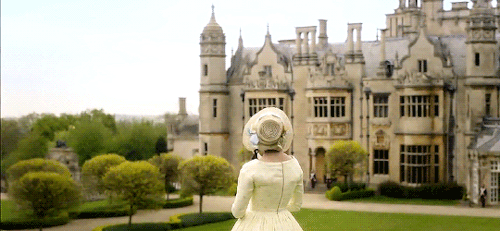
#writing#creative writing#writerscommunity#writer things#writersociety#on writing#writers#writeblr#writers on tumblr#writblr#writings#words#writer#write#writers and poets#writersofinstagram#writerscorner#writerslife#writing stuff#writing tools#writing prompt#writing community#writing tips#writing inspiration#writing advice#elderly#character profile#original character#character design#my characters
248 notes
·
View notes
Text
I made this post about how moved I am yr addressed racism with Felice/Simon. It prompted me ponder issues about this fandom (starting how the nonwhite characters are treated in this fandom, and if people would sympathize with Wille as much if he was black instead of white, for example. But then it spiraled into other things as well) I've never had the courage to post about before, but yr gave me courage lmao (putting a disclaimer that I don't hate any of the characters as people...actually I adore most of them...except August). This season showed how ingrained racism is, it exists in so many "invisible" ways, where people can act as if it's not real since it makes them uncomfortable to deal with their own hidden biases, or worse, because they think their biases are actually justified. I've seen some mentions about how the audience of this show reflects the exact prejudices the show claims to criticize.
There's a notable pattern where even minor rich kid characters receive disproportionate sympathy/recognition and others face unwarranted criticism, reflecting societal biases and how we are conditioned. While tumblr has been better this season especially with time, tumblr (and esp other social media) sites often have much more sympathy for Wille over Simon, for example. Simon across sites gets a lot of undue downright vile comments from the fandom, or is just disregarded more. Part of this could be because Wille is the main character, and Simon's perspective was not shown super well in season 2, but Simon/Omar often get a lot of comments that aren't unsimilar to the racist and vile comments we saw Simon get in the show. It made me wonder- if Wille had not been white, if he had been black, would people still have found as much sympathy for him during his angry outbursts? How strange that many people seem to find sympathy for Wille and even August, but not for Simon, even though if we are being realistic...Simon is an equally complex character that has not done many bad things? How interesting that people barely discuss Felice's storyline, but there are people that gag over the rich white kids, stederika and henry/walter (especially after Felice's storyline this season, and when we have Rosh as a canon sapphic lower class girl). How wild that the girls' storylines- Felice and Sara's- are disregarded? People often act like Wille and Simon have gotten the same amount of hate, but if you've been in this fandom long enough and seen the overall situation, I think people know that Wille is favored over Simon overall, and the hate/disregard they get is not equivalent, especially considering Simon is the second lead.
I'm not saying all of this is due to prejudice, or that everyone who has ever done these things is an awful person, it's more just an observation that if we are honest with ourselves, hidden biases certainly play a role in ALL of our thoughts/behaviors. Even for those who may not actively engage in it, do we enable it? And with a show like Young Royals that is attempting to (not always succeeding, but an attempt was made this season) to critique these social structures of racism and classism, wouldn't it be nice if, as we go into this final episode, we look inwards and see what biases we may carry that affect our perception of this show, and more importantly, real life? Life imitates art, after all.
#young royals#wilmon#simon eriksson#felice ehrecrona#prince wilhelm#stederika#just some thoughts I'm not trying to start a fire here#just thought it would be cool if we think about some of the issues the show brought to the forefront#sara eriksson#damn I mentioned so many characters didn't I
114 notes
·
View notes
Text




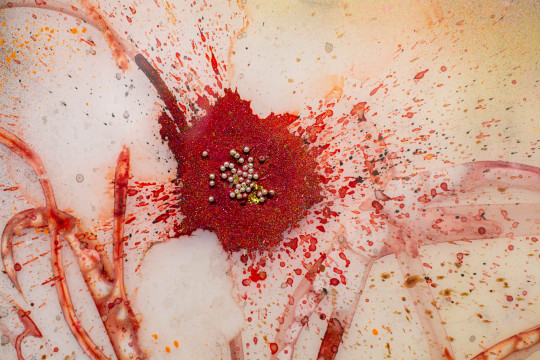
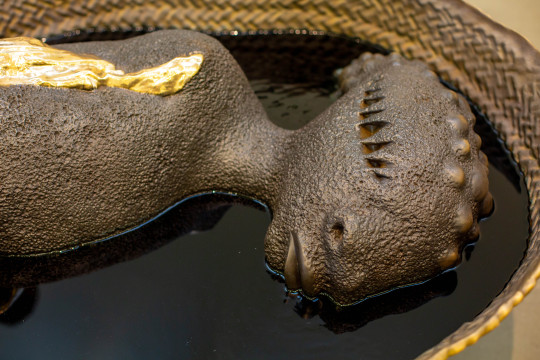



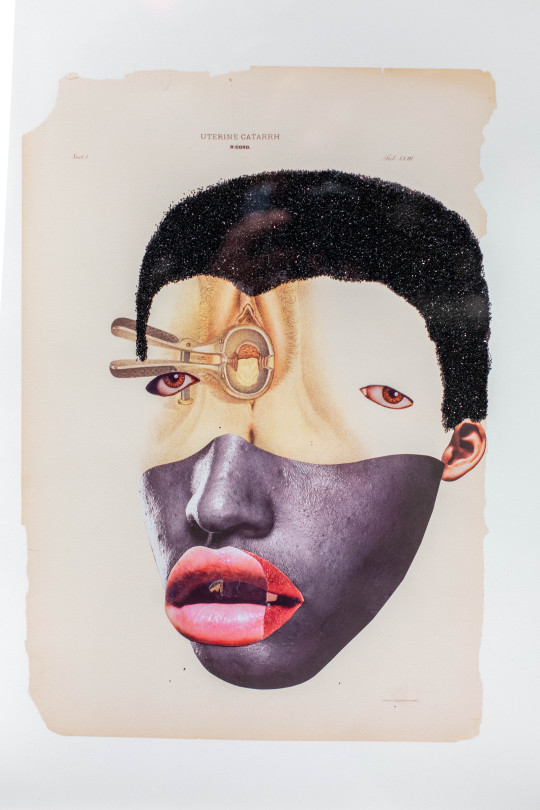



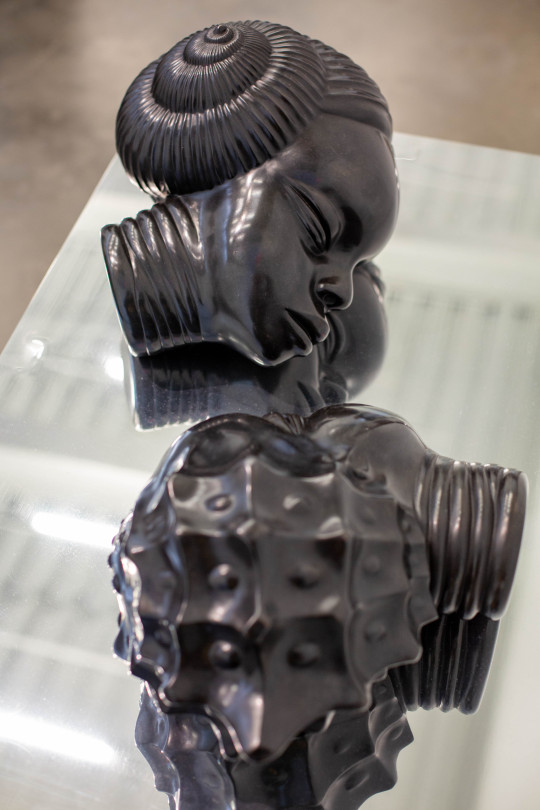


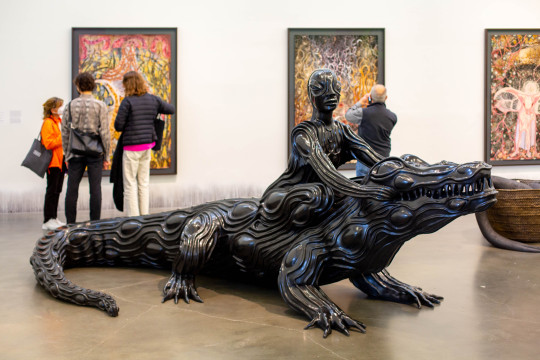





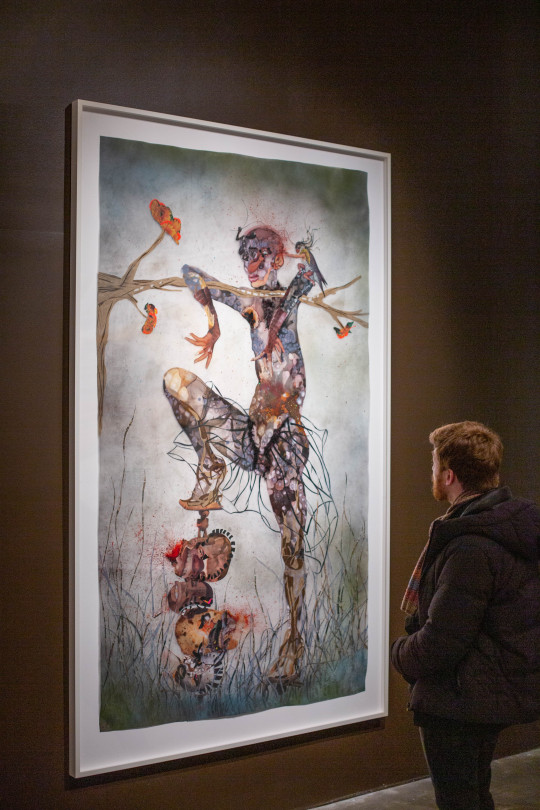
Unraveling Wangechi Mutu’s "Intertwined" at the Whitney Museum from 2023
Recently, I was reflecting on Wangechi Mutu's "Intertwined" which took place between March to June 2023 at the Whitney Museum. The exhibition brought together over one hundred works from across her twenty-five-year career. In cumulative form, her works form a rich tapestry of themes that resonate deeply with the human experience. Through intricate collages, sculptures, and installations, Mutu explores feminism, race, colonialism, identity, and environmental concerns with profound depth and complexity.
Central to Mutu's artistry is her use of diverse materials, particularly evident in her sculptures. From ethereal forms crafted from delicate textiles to imposing figures forged from found objects, Mutu's sculptures captivate with their materiality. Each piece tells a story of resilience and transformation, as raw materials are repurposed and imbued with new meaning. This material interplay serves as a metaphor for the interconnectedness of human experience, highlighting the ways in which disparate elements come together to form a unified whole.
Mutu's art challenges conventional notions of beauty and power, particularly through her celebration of the female form and her reimagining of cultural symbols. Empowering her subjects to transcend societal limitations, she invites viewers to reconsider their perceptions of self and other. Additionally, Mutu prompts reflection on humanity's relationship with the natural world, highlighting interconnectedness and the responsibility to steward the earth. "Intertwined" serves as both a call to action and a testament to the transformative power of art, urging us to confront the complexities of our existence and to imagine new possibilities for the future.
Imagery by: Blair Prentice (iheartmyart)
55 notes
·
View notes
Text
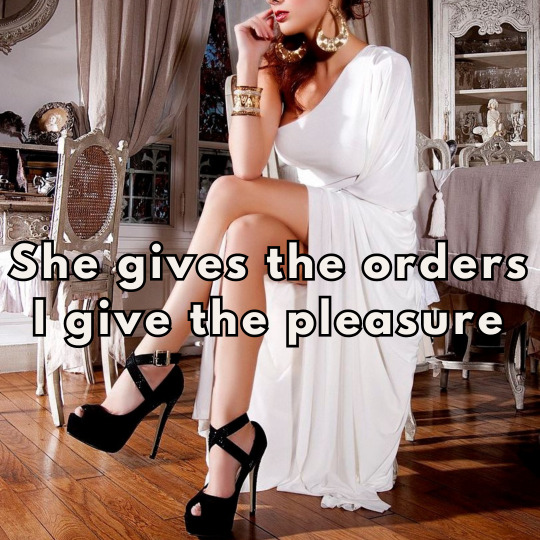
She gives the orders I give the pleasure
Camille and Marc met at a casual get-together among friends. Both were drawn to the other's genuineness and simplicity. Love blossomed organically between them, and it wasn’t long before they decided to embark on the journey of shared life.
Initially, their relationship followed a more traditional dynamic. Camille handled household duties, while Marc, more often away due to his job, played the role of the primary financial provider. However, as years passed, Camille climbed the rungs in her professional field, emerging as a dominant figure. She possessed not only astute strategic vision but also a knack for balanced and wise decision-making.
On the flip side, Marc began to feel the weight of the constant pressures from his job. He started exploring his passions, notably cooking and the arts. He found immense joy in pampering Camille, surprising her with gourmet meals, and creating a cozy ambiance at home.
One evening, amid a deep discussion about the future and their aspirations, Camille broached the idea of a Female-Led Relationship (FLR). She had never considered it before, but the concept oddly seemed to align with the natural evolution of their relationship. Marc, always open-minded and inquisitive, was keen to explore this dynamic.
The shift wasn’t immediate. They had to navigate through their insecurities, fears, and societal stereotypes. Yet, from their dialogues emerged a mantra: "She gives the orders, I give the pleasure." For Camille, this meant she could lead their relationship drawing from her insight and intuition. For Marc, it indicated an opportunity to discover his strength in delivering joy and comfort to Camille’s life.
Camille found a distinct liberation in this new dynamic. She felt empowered, knowing Marc stood by her, not as a mere follower but as a partner celebrating her lead. Marc, in turn, experienced deep satisfaction in dedicating himself to Camille’s well-being, deriving joy from the minutest details, from romantic surprises to intimate moments shared.
Their friends and family were taken aback by this shift. While some were skeptical, others were in awe. But for Camille and Marc, the FLR dynamic wasn't about a power play but a genuine exploration of individual strengths.
Their story stands as a testament that love doesn’t conform to a single mold. Every couple can define their own dynamic, in tune with their desires, aspirations, and personal growth. For Camille and Marc, "She gives the orders, I give the pleasure" wasn’t just a mantra—it was a reflection of a bond built on mutual respect, trust, and admiration.
She Gives the Orders, I Give the Pleasure: Dynamics of a Female-Led Relationship
In the realm of relationships, myriad dynamics exist. From traditional to modern, every couple establishes a rhythm that harmonizes with their individual personalities. Among these diverse dynamics is the Female-Led Relationship (FLR), where traditional roles are often flipped or rearranged, carving a unique space of mutual respect and understanding. At the heart of this dynamic, you'll often find a mantra of sorts: "She gives the orders, I give the pleasure."
At first glance, this may seem like a simple exchange of roles, but beneath the surface, it is far more intricate.
She Gives the Orders
An FLR is defined not by dominance, but by leadership. The woman in such a relationship takes on the primary decision-making role. This isn't about superiority, but about trust. The man trusts her judgment, her wisdom, and her insight. She may determine the financial strategy of the household, make major life decisions, or even establish certain rules or boundaries in the relationship.
But let's be clear, her role is not about imposing dictatorship. It's about navigating the relationship ship through life's vast ocean, steering clear of tempests and ensuring both reach their desired haven. The man isn’t rendered powerless or voiceless; he has entrusted her with this leadership, finding solace in her capability.
I Give the Pleasure
This is not merely a reference to the physical. Pleasure, in this context, is multifaceted. It refers to emotional, mental, and physical contentment. The man’s primary focus is on ensuring her happiness, her well-being, and her satisfaction. This dedication doesn't diminish him but rather empowers him. His strength is showcased in his ability to cater, understand, and respond to her needs and desires. In doing so, he often finds his own fulfillment.
The pleasure aspect is a symphony of acts - from understanding her emotions, supporting her ambitions, to even those intimate moments shared. It's about creating a space of absolute comfort and ensuring she feels valued, cherished, and adored.
Mutual Growth and Understanding
An FLR, like any other relationship, thrives on mutual respect and understanding. "She gives the orders, I give the pleasure" isn’t about one side having an upper hand. It's about playing to each other's strengths, understanding each other's roles, and growing together as partners.
In society, this dynamic might challenge conventional relationship norms. But love is not confined by convention. It is defined by the people in it and the joy they derive from it. For those in a female-led relationship, this unique dynamic offers a space where both can flourish, guided by trust and mutual admiration.
In conclusion, an FLR is not a challenge to the norms but a testament to the versatility of love and relationships. In a world that continues to evolve, relationships, too, adapt, finding new ways to express love, trust, and commitment.
#gynarchie#matriarchie#femaleledrelationship#gynarchy#matriarchy#femalesupermacy#femaleledworld#keyholder
230 notes
·
View notes
Text
as yr favorite local jason todd fan sometimes i get so fed up with the apparent inability of most dc comic writers to write a class conscious narrative about him.
and yes, i know that comics are a very ephemeral and constantly evolving and self-conflicting medium.
and yes, i know they’re a profit-driven art medium created in a capitalistic society, so there are very few times where comics are going to be created solely out of the desire to authentically and carefully and deliberately represent a character and take them from one emotional narrative place to another, because dc cares about profit and sometimes playing it safe is what sells.
and yes, i know comics and other forms of art reflect and recreate the society within which they were conceived as ideas, and so the dominant societal ideas about gender and race and class and so on are going to be recreated within comics (and/or will be responded to, if the writer is particularly societally conscious).
but jesus christ. you (the writer/writers) have a working class character who has been homeless, who has lost multiple parents, who has been in close proximity to someone struggling with addiction, who has had to steal to survive, who may have (depending on your reading of several different moments across different comics created by different people) been a victim of csa, who has clearly (subtextually) struggled with his mental health, who was a victim of a violent murder, and who has an entirely distinct and unique perspective on justice that has evolved based on his lived experiences.
and instead of delving into any of that, or examining the myriad of ways that classism in the writers’ room and the editors’ room and the readers’ heads affected jason’s character to make sure you’re writing him responsibly, or giving him a plotline where his views on what justice looks like are challenged by another working class character, or allowing him to demonstrate actual autonomy and agency in deciding what relationships he wants to have with people who he loves but sees as having failed him in different ways, or thinking carefully about what his having chosen an alias that once belonged to his murderer says about his decision-making and motivations, you keep him stuck in a loop of going by the red hood, addressing crime by occupying a position of relative power that perpetuates crime & harm rather than ever getting at the root causes, and seesawing between a) agreeing with his adoptive family entirely about fighting nonlethally in ways that are often inconsistent with his apparent motivations or b) disagreeing and experiencing unnecessarily brutal and violent reactions from his adoptive father as if that kind of violence isn’t the kind of thing he experienced as a child and something bruce himself is trying to prevent jason from perpetuating. because a comic with red hood, quips, high stakes, and familial drama sells.
it doesn’t matter if it keeps jason trapped, torn between an unanswered moral and philosophical question, a collection of identities that no longer fit him, and a family that accepts him circumstantially. it doesn’t matter if jason’s characterization is so utterly inconsistent that the only way to mesh it together is to piece different aspects of different titles and plotlines together like a jigsaw. it doesn’t matter if you do a disservice to his character, because in the end you don’t want to transform him or even understand him deeply enough to identify what makes him compelling and focus on that.
and i love jason!!!!! i love him. and i think about the stories we could have, if quality and art and doing justice to the character were prioritized as much as selling a title and having a dark and brooding batfam member besides bruce just to be the black sheep character are prioritized. and i just get a little sad.
#jason todd#jason todd meta#red hood#batfam#batman#dc comics#comic analysis#classism#tw: csa mention#maybe someday half of the most intriguing and nuanced aspects of his character will be touched upon#red hood outlaw 51-52 had some cool moments wrt jason + class + hometown friends + systems of power but. that was a two issue arc#and even then it was admittedly messy#GOD i want him to be three dimensional and well rounded and well used#even if a writer wrote a fucking. filler comic for an annual or smthn exploring what jason does outside of being red hood#keep the name if u want. have him have deliberately taken the name of his killer and twisted it until ppl from his city know rh#as a protector of kids and the poor and sex workers and so on. that WORKS. but show him connecting w his community#have him get involved in mutual aid. have him do something when he’s not out as red hood at night. let us see jason & barbara interact more#or jason and steph !!!!!!!! or another positive but complicated dynamic (he has a lot of those)#i just. i think that his stagnancy makes me fucking sad. i liked some aspects of task force z. felt like it ended too soon tho#FUCK the joker lets unpack his self concept & have him be a real person outside of vigilanteism (?) and vengeance#i liked some aspects of the cheer arc in batman urban legends mostly bc he had SOME agency and bc he wasn’t completely flat#even tho i hate the retconning of robin jason being angry and moody and so on#part of the problem is we don’t see him too too often for more than semi brief appearances so im so happy to see him i’ll just accept it#love the idea of a nightwing & red hood team up comic. hate that tom taylor a) wrote it and b) gave jason that stupid ass line abt justice#u think this man trusts cops ????? or the legal system !????????? BITCH.#get jason todd into like a sociology / gender and intersectionality / feminist studies class NOWWWWW#ok im done im sleepy and going to watch nimona. thx for reading to anyone who did#PLS anyone who reads this let me know what u think im frothing at the mouth rn#wes.txt#mine
267 notes
·
View notes